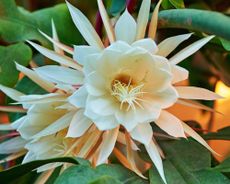History Of Passionflowers


The plant world boasts more than 500 species of passionflower plants, almost always on vines but occasionally as shrubby plants. Either way, this beautiful heirloom plant is certainly rich in both history and legend. Read on to read about passionflowers through time.
Passionflower Vine History
Passionflower (Passiflora spp.) is native to South America and the fruit was cultivated by Incas, Aztecs, and other indigenous people for thousands of years. The history of passionflowers tells us that European botanists and Jesuit priests became fascinated with the passionflower vine following the conquest of South America and the Incas. History buffs think the unique bloom reminded botanists of the suffering of Christ on the cross, with the corona symbolizing the crown of thorns, five anthers representing five wounds, and three stigmas representing the nails used in the crucifixion. Some historians believe the great interest in the passionflower was an indication of the terrible guilt many Europeans experienced following Pizarro's brutal religious suppression, forced Christianity and resulting carnage of the Incan people. Others think the victors were looking for a sign absolving them of guilt. Over the years, the plant's popularity grew, due to its great beauty, Christian symbolism and sweet flavor. The plant was used medicinally as a mild sedative, but its use expanded even more when early settlers in North America's Gulf Coast area learned that Native Americans used the plant medicinally as a mild sedative and a poultice for cuts and bruises. Early herbalists used the plant as a remedy for a number of maladies, including epilepsy, insomnia, whooping cough, anxiety, depression, menstrual cramps, and diarrhea. Today, herbal medicine practitioners continue to use passionflower as a mild tranquilizer, pain reliever and digestive aid, although there appears to be no solid scientific proof of its effectiveness. The plant is still widely recognized as a symbol of the Passion of Christ. It is a favorite of warm climate gardeners who appreciate its ornamental value.
Gardening tips, videos, info and more delivered right to your inbox!
Sign up for the Gardening Know How newsletter today and receive a free download of our most popular eBook "How to Grow Delicious Tomatoes."

A Credentialed Garden Writer, Mary H. Dyer was with Gardening Know How in the very beginning, publishing articles as early as 2007.
-
 7 Best Dwarf Tomato Plants
7 Best Dwarf Tomato PlantsHave a tiny growing space? Look for dwarf tomato seeds so you don’t miss out on summer’s juicy bounty.
By Susan Albert
-
 5 Night-Blooming Houseplants – Grow An Indoor Moon Garden
5 Night-Blooming Houseplants – Grow An Indoor Moon GardenThere is something uniquely special about night-blooming houseplants. Set the scene for a magical evening indoors with these fragrant flowering beauties.
By Amy Grant